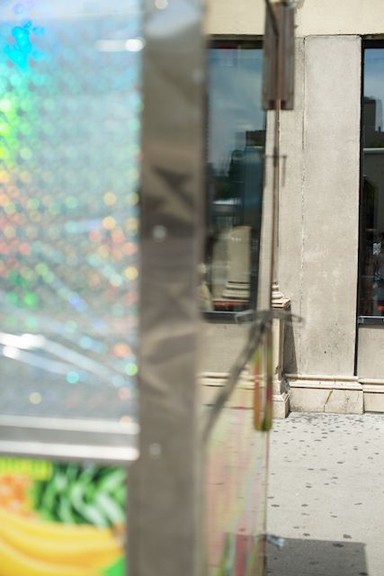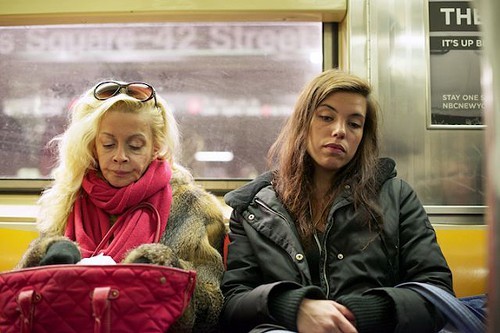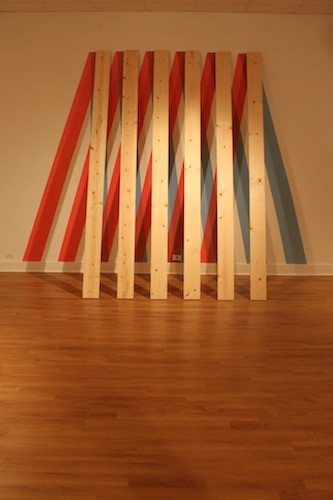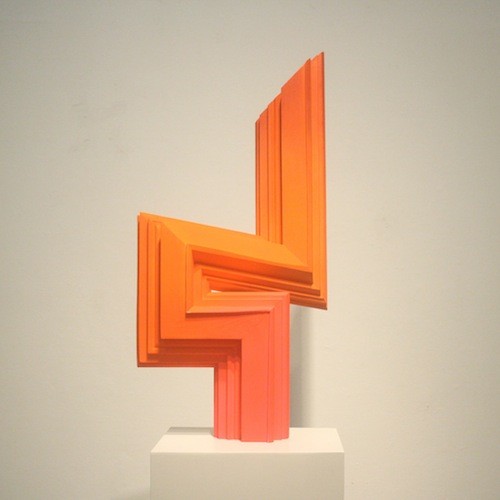Two very different exhibitions currently on display in Memphis galleries share a formal attention to shape, light, and color. Huger Foote, a photographer of the understated, makes work that matches something in the character of Holly Cole’s rhythmic, geometrical sculptures.

Foote, a Memphis-born and New York-based artist, is showing a new collection of color photography, “Sixteen,” at David Lusk Gallery. The show runs through November 16, with an opening reception tonight, October 18th, from 6 to 8 p.m. Displayed alongside is work by painter Libby Johnson.
Foote’s lens is focused on moments of long-lit quiet. In one photograph, a metal fence casts an array of shadows. In another, grass grows patchily near the lip of a sidewalk.
The work pays clear tribute to William Eggleston, but is less atmospheric and more formal. In many of Foote’s photos, a single, vertical element divides the frame. Spare instances of saturated color are noted against pale backgrounds, a technique that serves to emphasize shape and line within the composition.
[jump]


Foote’s photographs are not scenes so much as they are details that suggest scenes. Or, they are details that suggest other details— a group of peaches in one photo echo the curvature of a pedestrian traffic arrow in another. The collection’s sole portrait ( of two women riding the NYC subway) seems less about the women and more about how pink a scarf looks against platinum blonde hair.
Foote got his start as a commercial photography assistant in Paris, and continued commercial work in New York City. While on an extended trip home to Memphis, he began to make creative work “to fill the time and keep in practice.” Foote’s monograph, “My Friend From Memphis,” features much of this early work.
Though “Sixteen” is a clear outgrowth from Foote’s start in Memphis, the content of the work is more broadly sourced. It seems, also, less constrained: paragraphs, where there were sentences. The artist’s chief concern remains, however, syntactical.
He acknowledges as much: “There are surprises in the work sometimes — sometimes purely on the level of composition.”

At the University of Memphis Fogelman Gallery, Cole has an impressive solo exhibition, “Duality.” She was invited to show as a part of the Fogelman’s BFA Selects series, which features outstanding recent university alumni. The show, which opened earlier this month, ends October 25th.
Cole’s show features brightly hued sculpture and painting, and some pieces that are arguably both or neither. (What can you call a three dimensional piece mounted on a wall?) For her 3-D work, she uses prepared wood to create abstract, geometrical forms. The pieces are painted chemical shades of pink or blue or orange, and directly lit, so that shadows form a dense underlay for each work.


In some pieces, the Cole employs color gels to filter lighting on her pieces, so that different shadows are cast in different colors. Cole, who plays in the band The Memphis Dawls, says that she got the idea from stage lighting.
The show’s most notable 2-dimensional work is a multimedia drawing that Cole executed on a faded projection screen. In the piece, black lines are cut out of the screen into a shape that echoes the geometries of the rest of the Cole’s work. The wall behind the screen is painted hot pink and under-lit, so that the drawing has an eerie dimensionality.
Cole’s work is almost too well-executed. For a show that depends heavily on changeable elements like light and shadow, and that deals in shapes that are organically wrought out of odd angles and joints, the overall effect is too contained. She could really get weird with it.
Both Cole and Foote are skilled makers whose work takes different approaches to important questions about how simplicity and form operate visually.
Foote images courtesy of David Lusk Gallery; Cole images: Lester Merriweather